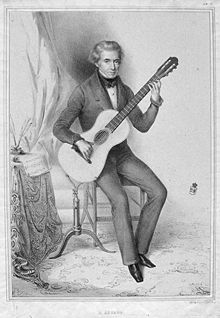
Dionisio Aguado y García (8 April 1784 – 29 December 1849) was a Spanish classical guitarist and composer of the late Classical and early Romantic periods.
Biography
Born in Madrid, he studied with Miguel García. In 1826, Aguado visited Paris, where he met and became friends with and for a while lived with Fernando Sor. [1] Sor's duo Les Deux Amis ("The Two Friends") commemorated the friendship: one part is marked "Sor" and the other "Aguado."
Aguado's major work Nuevo Metodo Para Guitarra was a guitar tutorial published in 1843. [1] As of 2011, it is still in print, with Tecla Editions releasing a reprint in 2005. [2] In the Escuela Aguado describes his use of fingernails on the right hand as well as his invention of a "tripodison": a device that held the guitar and thus minimized the damping effect of the player's body on the guitar's back and sides. [3] Aguado's other works include numerous waltzes, minuets, and other light pieces. The more extended works require a virtuoso technique and left-hand stretches that are almost impossible on the longer string lengths of modern guitars. (See Frederick Noad, "The Classical Guitar")
Aguado returned home to Madrid in 1837 and died there aged 65. [1]
Aguado's surname comes from the Spanish word for "soaked." (This is because an ancient relative of his, who was a knight, returned after a battle caked in mud. The nickname then eventually became the surname. [3])
Instruments used by Aguado y García
Of the instruments used by Aguado, two which were built by
- Pierre René Lacôte, (Paris 1838) and
- Etienne Laprevotte, (Paris 1838)
are held at the Museo Arqueológico Nacional in Madrid. Aguado is known for having used a tripod to support his guitar. [4] [5] [6]
List of works
- Op. 1 : Douze Valses
- Op. 2 : Trois Rondo Brillants
- Op. 3 : Huit Petites Pièces
- Op. 4 : Six Petites Pièces
- Op. 5 : Quatre Andantes et Quatre Valses
- Op. 6 : Nouvelle Méthode de Guitare (1834)
- Op. 7 : Valses Faciles
- Op. 8 : Contredanses et Valses Faciles
- Op. 9 : Contredanses non difficiles
- Op. 10 : Exercices Faciles et Très Utiles
- Op. 11 : Les Favorites - Huit Contredanses
- Op. 12 : Six Menuets & Six Valses
- Op. 13 : Morceaux Agréables non difficiles
- Op. 14 : Dix Petites Pièces non difficiles
- Op. 15 : Le Menuet Affandangado
- Op. 16 : Le Fandango Varié
Works without Opus number:
- Allegro
- Coleccion De Andantes, Valses Y Minuetos
- Douze Walses, Une Marche Militaire, Et Un Theme Varie
- Escuela de Guitarra (1825)
- Gran Solo (Fernando Sor's Op.14, Arr. by Aguado)
- Muestra De Afecto Y Reconocimiento (Seis Valses)
- Valses Characteristiques
- Variaciones
- Variaciones Brillantes
- Mazurka (Polish national song, Arr. by Dionisio Aguado)
- Adante by Dionisio Aguado
References
- ^ a b c Jeffery, Brian. "Dionisio Aguado: New Guitar Method: The complete introduction". Dionisio Aguado: New Guitar Method. Tecla Editions. Retrieved 13 August 2011.
- ^ "Dionisio Aguado: New Guitar Method". Catalog. Tecla Editions. Retrieved 13 August 2011.
- ^ a b Lewis, Alastair. "The Biography of Dionisio Aguado 1784-1849". Maestros-of-the-guitar.com. Retrieved 13 August 2011.
- ^ Lacote and Aguado: about a Tripodison Archived 20 July 2011 at the Wayback Machine by Sinier de Ridder
- ^ El Fixateur (La Trípode) De Dionisio Aguado, "Una Cita Con La Historia" by Pablo de la Cruz
- ^ El Trípode De Aguado 175 Años Después
External links
Images of Aguado
Sheet music
- Rischel & Birket-Smith's Collection of guitar music 1 Det Kongelige Bibliotek, Denmark
- Boije Collection The Music Library of Sweden
- creativeguitar.org Archived 27 January 2010 at the Wayback Machine (sheetmusic largely compiled from the above primary sources)
- Free scores by Dionisio Aguado y García at the International Music Score Library Project (IMSLP)
- Dionisio Aguado – Complete Works (Integrale) for Classical Guitar Classical Guitar Library
